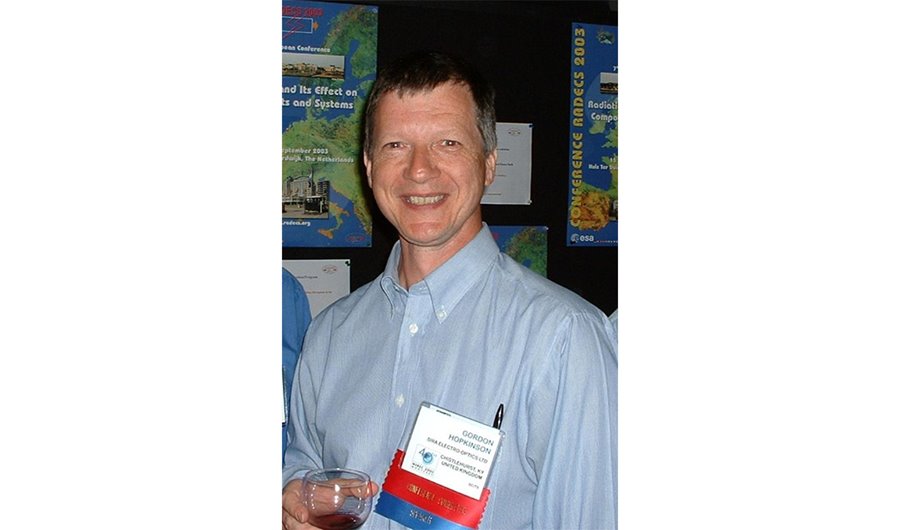
Physicist who made a notable contribution to the development of today’s space imaging systems, Gordon Hopkinson was one of the world’s experts in the physics of optical detectors used in a wide range of applications from digital cameras through to international space missions and even mobile phones. For three decades he was involved in detailed analysis and modelling of solid state cameras and contributed significantly to the research of their use in a wide range of applications from X-ray mammography, the mapping of the stars to the search for dark matter.
His ability to undertake detailed measurements, identify new phenomena and develop the underlying mathematical models was second to none. Gordon was also a very kind person, modest and with a high standard of integrity. He will be sorely missed by friends and colleagues both within the UK and across the world.
Hopkinson began his research at Manchester University with spells at Durham and Leicester undertaking research into astronomy, such as spectral investigations of comets and observations of zodiacal dust. His move to Leicester coincided with the emergence of the new and revolutionary solid state detectors based on silicon chips, known as Charge Coupled Devices (the heart of today’s digital cameras). The first of these were developed in the UK in 1972 by EEV (subsequently known as e2v). The Charge Coupled Devices (CCD) would replace the previous bulky vacuum tube detectors and eventually give rise to the demise of photographic film.
At Leicester University Hopkinson developed ground breaking techniques for achieving low noise performance from CCDs and together with David Lumb wrote the definitive paper on the subject. These techniques were subsequently applied to the new breed of space imaging missions and are still used to this day. He has several publications in this field and numerous citations. The research that Hopkinson undertook at Leicester would shape his professional life.
In 1983 Hopkinson moved to the Sira research and development organisation in Kent and immediately found that his expertise in CCDs was essential to fully exploit the capabilities of these devices in a range of new and highly demanding space instrumentation. Hopkinson’s first task was to support the development of the state of the art star trackers and a star mapper for a X-ray satellite mission called ROSAT, funded by the German Space Agency and launched in 1990. The ROSAT mission undertook an all-sky survey of x-ray emitting objects and led to a detailed morphology of supernova remnants and clusters of galaxies. ROSAT operated until 1999. Similar applications soon arose in the use of CCDs for first inter-satellite laser communications system (SILEX), oceanographic monitoring (MERIS) and the measurement of ozone from space (GOMOS), all of which are still in operation today providing invaluable information and capabilities to the European science community.
Hopkinson’s key expertise was not only in achieving high performance from solid state detectors but also analysing the complex effects arising from the harsh space radiation environment of protons and gamma rays. This was a special interest that led to international recognition. Of particular note was a request by the European Space Agency (ESA) for Hopkinson to undertake detailed radiation analysis on a new but highly demanding astrometric mission called GAIA. This mission aims to create the largest and most precise three dimensional chart of our Galaxy taking measurements of about one billion stars.
Hopkinson was a recognised international authority in his field of research and has published many papers, participated by invitation in NASA, ESA and Japanese working groups and acted as chairman at many international conferences. He not only received many credits for his work but through his considerable reputation and expertise sat on the Awards Committee of the Institute of Electrical & Electronic Engineers (IEEE).
Hopkinson moved with the Sira Space Group to Surrey Satellite Technology Ltd in 2006, the world leading small satellite manufacturer, and set up new facilities to continue his work. This has included continued research into detectors for space missions such as Solar Orbiter, to produce images of the Sun at an unprecedented resolution, EarthCARE, a joint European-Japanese mission addressing the need for a better understanding of the Earth’s climate, and EUCLID, with the primary goal to map and characterise the geometry of the dark universe, a feature of considerable interest to the science community.
Gordon Robert Hopkinson was born in 1952, the only child of Jessie and Alan and brought up in Nottingham. He was educated at Forest Fields Grammar School, Nottingham and went onto read Physics at Manchester University graduating with first-class honours in 1973, he then undertook a PhD graduating in 1977.
Gordon loved barbeques, walking, history, crosswords and real ale. Most family holidays involved incorporating as many of these as possible. Top of the list were camping holidays in France with barbeques every night and walking holidays in Derbyshire, where the route would be planned according to the beer.
He is survived by his wife, Jacqui, whom he married in 1980 and by their two daughters and son.
Gordon Hopkinson, detector physicist, was born on July 4th 1952. He died on September 12th 2010, aged 58.
About SSTL
Surrey Satellite Technology Limited (SSTL) is the world's leading small satellite company, delivering operational space missions for a range of applications including Earth observation, science and communications. The Company designs, manufactures and operates high performance satellites and ground systems for a fraction of the price normally associated with space missions, with over 300 staff working on turnkey satellite platforms, space-proven satellite subsystems and optical instruments.
Since 1981 SSTL has built and launched 34 satellites – as well as providing training and development programmes, consultancy services, and mission studies for ESA, NASA , international governments and commercial customers, with its innovative approach that is changing the economics of space.
Based in Guildford, UK, SSTL is owned by EADS Astrium NV.
www.sstl.co.uk